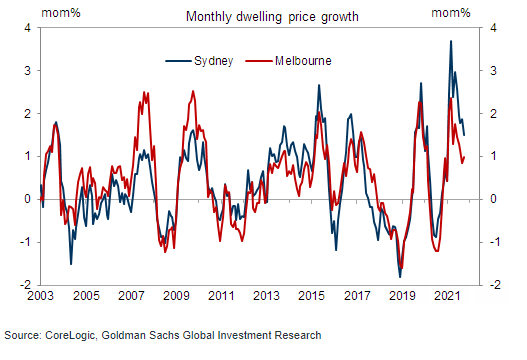“Out along the edges
Always where I burn to be
The further on the edge
The hotter the intensity”
Australian, and in particular Sydney property has been a spectacular investment, soaring by over 20 times since the early 1980s and significantly out-performing Australian equities. As of the June quarter, the median value of a Sydney property was A$1.4 million. Property across Australia has soared since the 2018 lows, but particularly in the past 12 months with the aggressive fiscal and monetary easing through the pandemic. But when is enough, enough?

As safe as houses.
Using Sydney data, it looks as if you can’t go wrong investing in real estate but there have been three extended periods when property has gone sideways to down. The early 1990s recession driven by excessive monetary tightening; 2005-2010driven by rate rises; then the GFC ‘s income hit; and lastly 2017-2019 when prices corrected ~20%, due to an official attempt to slow the market using macro prudential controls. The reality is that the market is a lot more volatile than implied by this chart. The RBAs recently released chart pack outlines just how volatile property has become.

So many factors go into the value of housing but in the end it’s a matter of supply, demand and affordability.
As the RBA published last week in its Chart Pack, housing prices as a ratio to disposable income are now at their most expensive and have accelerated significantly of late.

On supply, I would point you to Yarra Capital (and my old friend and colleague) Tim Toohey’s analysis from August this year.
https://www.yarracm.com/looming-housing-excess/
“We estimate that by the end of 2023 Australia will have 150k dwellings in excess of demographic demand. This would be the largest excess of housing since 2008, and this rather sombre forecast embeds as a base case of a 30% decline in dwelling approvals by the end of 2022.”
On a shorter time-frame, capital city auction volumes are over 3000 auctions each weekend for the 3rd consecutive week, up from less than 2000 for the same week a year ago.
What of interest rates?
As AFR contributor and Coolabah Capital Portfolio Manager, Christopher Joye has recently stated in his AFR article “Why house prices will rise beforethey fall 20pc”
“Yet, if and when the RBA does seek to normalise the cash rate, prices should fall, as night follows day. And if the RBA is able to lift rates by 100 basis points or more, it will likely be the largest correction on record.”
What about the level of interest rates? The RBA keeps saying they won’t raise rates until 2024.
The RBA on Friday stated that “… the Board judges that this outcome could be consistent with the first increase in the cash rate being in 2024.” So, while its sticking with the 2024 lift-off for rates, this RBA statement is data dependent (of course) AND the RBA has already moved to tighten policy by abandoning the three year bond target and reducing its bond buying program.
“In light of the faster-than-expected progress towards its goals and the revised outlook for inflation, the Board decided at its November meeting to discontinue the target for the yield on the April 2024 Australian Government bond.”
Their next step will be the ongoing reduction of their bond buying program and that next step is likely in March.
Be careful on rates, the RBA is already slowing unwinding the extraordinary monetary policy. This is a slow but steady tightening of policy.
Variable mortage rates close to 2% are still on offer although the move in the three year interest rate swap market highlights the risk that mortgage rates will move higher.

Before you see an outright price decline, the pace of any increases needs to fall. This is exactly what is happening in Sydney and Melbourne property.

To summarize, property is moving towards an over supply, policy tightening has begun which is likely to lead to higher mortgage rates, macro prudential controls have also begun with APRA’s modest adjustment to mortgage serviceability buffers, affordability is at historically low levels already, especially in Sydney, and the rate of price increases is already declining.
It all screams, be extremely cautious on property.
"DangerZone" was released in 1986 by Kenny Loggins. The song was one of the hit singles from the movie 'Top Gun'.
David 'Bushy' Nolan
Strategic Engagement
+61 (0) 409 881 910